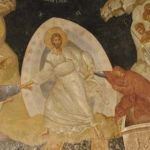Во имя Отца и Сына и Святого Духа.
Сегодня празднуется память свв. Захарии и Елисаветы, родителей св. Иоанна Предтечи. Но также в этот день мы совершаем память св. Петра и Февронии Муромских в честь второго обретения их мощей. Их мощи после революции в России были поруганы большевиками и помещены в музее, а после падения коммунизма опять возвращены для поклонения верующих, и в память этого установлено им празднование в сентябре.
Русские святые преп. Петр и Феврония, князья Муромские почитаются как покровители семейной жизни. Замечательно их житие. До монашества их имена были Давид и Евфросиния. Они жили в начале 13 в., до нашествия монголов. Молодой князь Муромский Давид тяжело заболел и ему было открыто во сне, что одна девица, простая крестьянка Евфросиния может исцелить его. Князь нашел эту девушку, которая знала искусство врачевания, и был поражен ее красотой и умом. Евфросиния вылечила князя, и они поженились. Но Муромские бояре, а особенно их жены, негодовали, что простолюдинка будет их княгиней, и они поставили князю ультиматум: или развестись с женой, или оставить княжение.
Княжеская чета должны были уехать из своего города. Они много бедствовали от нищеты и неудобств. Евфросиния утешала и укрепляла князя Давида надеяться на Бога, а он никогда не укорял ее, что из-за нее он потерял княжеский престол. Тем временем в Муроме начались беспорядки и смятения из-за отсутствия твердой княжеской власти, и горожане потребовали от бояр вернуть св. князя на престол.
Так их скорбь сменилась на радость. Св. Давид и Евфросиния долго и счастливо княжили в Муроме. В конце жизни они постриглись в монашество с именами Петра и Февронии, и поступили в монастыри мужской и женский. Они умерли в один день и завещали положить их в один гроб, который они заранее приготовили. Но духовенство посчитало, что не подобает положить в один гроб монаха и монахиню, и похоронили их раздельно. Но на другой день они чудесно оказались в одном гробе.
Св. Петр и Феврония – почитаются как покровители семейной жизни. Им молятся о помощи найти себе супруга или супругу.
Замечательно, что их семейный союз начался во временной жизни, но он уже не окончился во времени, а продолжился на всю вечность.
Может быть, мои слова покажутся преувеличением, что союз брака не ограничивается земной жизнью, а простирается и в будущий век.
Конечно, Евангелие говорит, что в будущей жизни не женятся ни выходят замуж, но пребывают как ангелы на небесах (Матф. 22,30). Т. е. в Царстве Небесном не будет такой семейной жизни, как на земле. Но союз любви между супругами не окончится и за гробом.
Можно на это возразить, что если один из супругов умрет, то вдовец или вдова могут вступить в новый брак, и отсюда следует, что брачный союз сохраняет свою силу только в этой земной жизни. Но не нужно забывать, что Церковь только по снисхождению допускает второй брак, но не одобряет его, напротив, смотрит на него как на слабость. По мысли Церкви, брак должен быть один. Поэтому для духовенства второй брак не допускается, так как священство должно быть примером нравственной жизни.
Те, кто когда-либо присутствовали на богослужении бракосочетания, могли заметить, что чин венчания весь наполнен символами, и там мы все время видим круг. Круглые кольца, круглые венцы, троекратное круговое хождение. Круг – это символ вечности, потому что круг не имеет окончания. Это указывает на вечность, неразрушимость брачного союза.
То что брачный союз продолжится на всю вечность видно также из того, что среди святых, прославленных Церковью, немало супружеских пар. Они имеют общий день памяти, одну церковную службу, их вместе изображают на иконах, как например, св. прор. Захария и прав. Елисавета, которых память мы сегодня совершаем. Значит, и в вечном блаженстве они не разделились, но пребывают вместе.
Замечательно то, что среди святых супружеских пар есть и такие, кто закончил жизнь в монашестве, т. е. до своей кончины они проводили жизнь раздельно, но несмотря на это, они прославляются Церковью вместе: например, празднуемые сегодня Св. Петр и Феврония, также преп. Андроник и Афанасия, небесные покровители нашего Владыки Андроника, преп. Ксенофонт и Мария, преподобномуч. Галактион и Епистима и другие.
В молитвах венчания воспоминаются некоторые из таких святых супружеских пар. Это Авраам и Сара, Исаак и Ревекка, Захария и Елисавета и др. Церковь воспоминает этих святых супругов в чине венчания, прося их молитв о вступающих в брак и предлагая их как пример святой, праведной семейной жизни по заповедям Божиим.
Молитвами святых супругов, Захарии и Елисаветы, Петра и Февронии, да поможет нам Господь подражать им.
Аминь
In the name of the Father and of the Son and of the Holy Spirit.
Today we celebrate the memory of Saints Zechariah and Elizabeth, parents of St. John the Baptist. We also, on this day commemorate Saints Peter and Fevronia of Murom in honour of the second translation of their relics. After the revolution in Russia their relics were desecrated by the Bolsheviks and placed in a local museum and after the fall of communism returned to the temple for veneration by the faithful. In memory of this event a celebration was established for them in September.
The Russian Saints Peter and Fevronia, princes of Murom are revered as patrons of family life. The story of their life is captivating.
They lived at the beginning of the 13th century before the Mongol invasion of Russia. Before their monastic tonsure, their names were David and Euphrosinia. The young prince David of Murom fell seriously ill, and it was revealed to him in a dream that a village girl Euphrosinia, a daughter of a wild honey picker, could heal him. The prince found this girl who knew the art of natural healing. He was struck by her beauty and intelligence and wished to marry her. Euphrosinia healed the prince, and they got married. However, the Murom boyars, (the nobility) and especially their wives, were indignant that a commoner would be their princess, and they presented an ultimatum to the Prince: either divorce his wife, or leave the throne.
The princely couple had to leave their own city. They endured much through poverty and misfortunes. Euphrosinia comforted and strengthened the Prince, instructing him to put all hope in God, while he never reproached her that because of her, he lost his throne. Meanwhile, riots began in Murom due to the lack of firm governance, and the townspeople demanded that the boyars return the holy prince to his throne.
Thus, their sorrow was replaced with joy. Saints David and Euphrosinia reigned happily in Murom for many years. At the end of their lives, they were tonsured as monastics with the names of Peter and Fevronia, and entered male and female monasteries. They died on the same day and willed that they be placed in the one coffin, which they ordered beforehand. But the clergy deemed that it’s not befitting to place a monk and nun in the same coffin, and buried them separately. However, the next day they were found miraculously in the one coffin.
Holy princes Peter and Fevronia are patrons of family life. Those who ask their intercession they help to find a spouse, and to have a peaceful life in marriage.
It is remarkable that their family union began during the temporal life, yet didn’t end in time but continued into eternity.
My words may seem an exaggeration that a marriage union is not limited to life on earth, but extends into eternity.
Of course, the Gospel states that in the future life “they neither marry nor are given in marriage but are like Angels in heaven” (Matth. 22,30), i.e. there won’t be a family life in the Heavenly Kingdom like there is on earth. However, the union of love between spouses will not end beyond the grave.
One can object to this with should one spouse die, the widower or widow can enter into a new union, which follows that marital union retains its potency only in this earthly life. But we must not forget that only through condescension that the Church allows a second marriage, viewing it as a weakness. According to the Church, there should only be one marriage. That’s why a second marriage is not permitted for the clergy as priesthood must be an example for a moral life.
Those who were ever present at wedding, may have realised, that the rite of wedding is full of symbols, and throughout the ceremony we see a circle. Circular rings, Circular crowns, walking thrice in circle around the analogion. A circle is a symbol of eternity because a circle has no end. This indicates eternity of the marriage union.
We may see that a marital union will endure for whole of eternity from the fact that among the Saints glorified by the Church, there are quite a number of married couples. The Church glorifies them as a couple. They have a mutual day of remembrance, one church service, and they are depicted together on icons, as an example holy Prophet Zechariah and righteous Elizabeth, whose memory we are celebrating today. It means that in eternal blessedness they are not separated, but abide together.
What’s remarkable is that among the Saintly married pairs there are those that ended their lives as monastics, i.e. before their demise, they led lives separately, but despite this, they were glorified by the Church together: for example, Saints Peter and Fevronia, celebrated today, likewise Saints Andronicus and Athanasia (heavenly patrons of our Vladyka Andronik), St. Xenophon and Maria, Holy martyrs Galacteon and Epistima.
In the prayers of the wedding service, some such Saintly pairs are remembered – they are Abraham and Sarah, Isaac and Rebecca, Zechariah and Elizabeth, Joakim and Anna, and others. The Church remembers these Saintly spouses in the rite of wedding, asking for their prayers for those entering into marriage and offering them as an example of a holy, righteous family life according to God’s commandments.
Through the prayers of the holy spouses, Zechariah and Elizabeth, Peter and Fevronia, and others may the Lord help us to emulate them.
Amen









